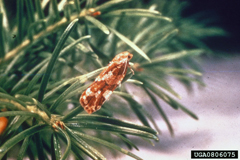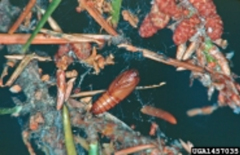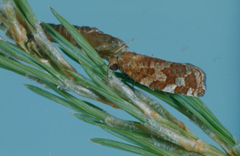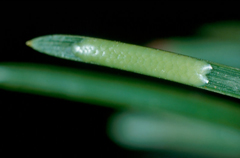Common Name
Jack Pine Budworm
Latin Name
Choristenaura pinus pinus Freeman
Main Host(s): Jack Pine (Pinus anksiana), Scots Pine (Pinus ylvestre)
Life Cycle
The Jack Pine Budworm produces one generation per year and while it prefers to feed on Jack Pine, Scots Pine, Red and White Pine can be occasional hosts as well. It can be also be found occasionally on fir and larch associated with Jack Pine stands. The Jack Pine Budworm is very close to the Eastern Spruce Budworm not only in its morphology but also in its biology; they both have six larval stages and very similar life cycles.

After overwintering under bark scales, early stage Jack Pine Budworm caterpillars start mining staminate flowers, cones, older needles and even the bark of twigs before the new foliage appears. A heavy Jack Pine flower crop supports a building larval population and has been associated with the rise of epidemic levels of Jack Pine Budworm. Jack Pine Budworm larvae are wasteful feeders; they chew needles off at the base but do not consume them entirely.

As the larvae grow, they web needles and the needle debris together to form a protective shelter where they will spend the greater part of their larval development. Pupation occurs from July to early August and lasts about 10 days. Most moths emerge in July but emergence may continue until late August and even early September (depending upon the location). After mating, about 10 days later, eggs are laid in clusters of 40 eggs on needles in the upper part of the crown of host trees. The young larvae form their hibernacula (small silk shelters) in bark crevices in which they overwinter without feeding.

Impact & Damage
Jack Pine Budworm is a native insect to North America. Natural stands of Jack Pine and plantations of Scots Pine around the Great Lakes in the US and in central Canada are susceptible to this budworm. Unlike the Spruce Budworm, Jack Pine Budworm outbreaks are more unpredictable and in recent times, have occurred every 10-12 years, and last three to four years in any given location. Jack Pine Budworm does not seen to follow the traditional 30-40 year cycle as does the Eastern Spruce Budworm. The upper part of the forest canopy is primarily affected by the Jack Pine Budworm. Extensive defoliation can cause significant impacts on individual tree and forest health. As with many defoliators, even one year of defoliation can cause a reduction in growth and yield. Extensive top kill of the forest significantly reduces the market value of the stands. Several years of defoliation by the Jack Pine budworm can cause significant tree and stand mortality.

Resources
Learn more about Jack Pine Budworm
Quick Links
Contact a Valent BioSciences public health representative.
Contact Us